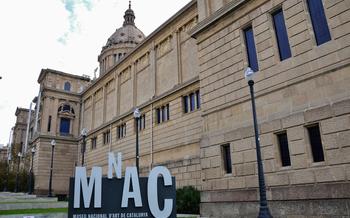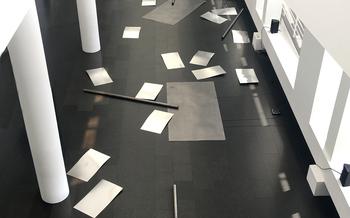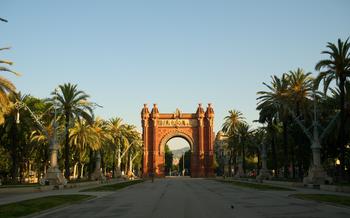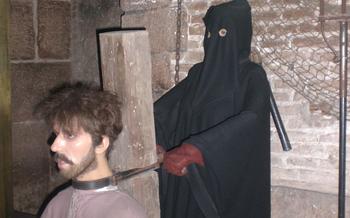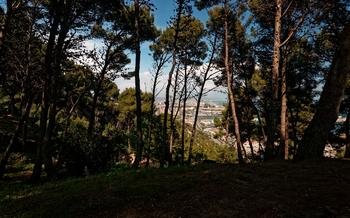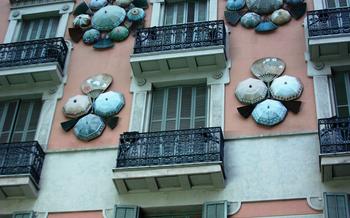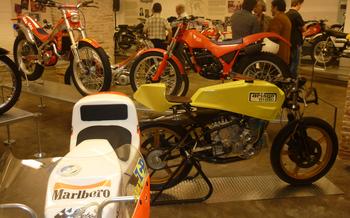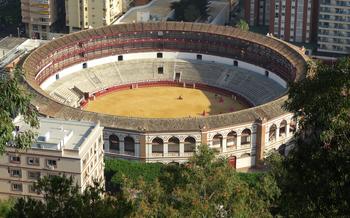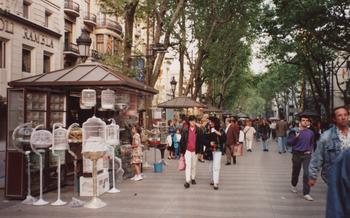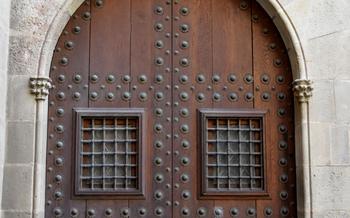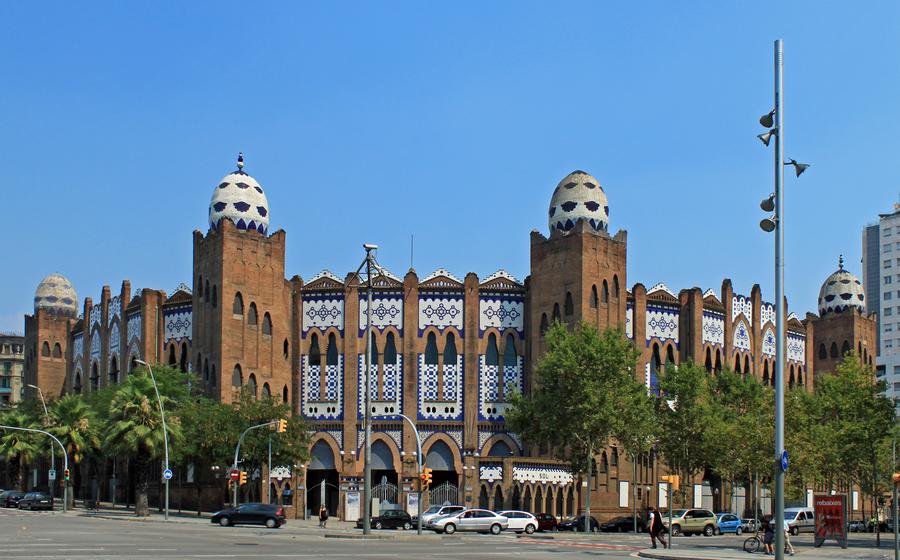
La Monumental
- Plaza de Toros Monumental: A Majestic Symbol of Barcelona's Bullfighting History
- Historical Significance: The Arena's Unique Legacy
- Barcelona's Bullfighting Culture: A Deep-Rooted Tradition
- Architectural Marvel: Exploring the Arena's Design
- Cultural Events and Performances: A Modern Transformation
- The Thrill of a Bullfight: Witnessing a Traditional Spectacle
- Museo Taurino de Barcelona: Delving into Bullfighting History
- Practical Information: Planning Your Visit
- Local Cuisine and Dining Experiences
- Transportation Options: Getting to the Arena
- Dress Code and Etiquette
- Safety and Security Measures: Ensuring a Peaceful and Enjoyable Experience
- Photography and Social Media
- Insider Tip: Hidden Gems and Unique Experiences
Plaza de Toros Monumental: A Majestic Symbol of Barcelona's Bullfighting History
The Plaza de Toros Monumental stands as a captivating symbol of Barcelona's bullfighting heritage, a tradition deeply woven into the fabric of Spanish culture. Its imposing presence evokes a sense of grandeur and spectacle, reflecting the significance of bullfighting in the city's past. Constructed in the early 20th century, the arena's architectural features showcase a blend of Catalan and neo-Mudéjar styles, creating a unique and awe-inspiring structure. However, the practice of bullfighting has sparked controversy and ethical debates regarding animal welfare, leading to its decline in popularity and a shift towards alternative cultural events and performances. Today, the Plaza de Toros Monumental represents a vibrant fusion of history, tradition, and contemporary creativity, offering visitors a glimpse into Barcelona's rich cultural tapestry.
Historical Significance: The Arena's Unique Legacy
The Plaza de Toros Monumental, a magnificent symbol of Barcelona's bullfighting heritage, stands as a testament to the city's cultural identity. Its origins can be traced back to the late 19th century, when the need for a larger bullring arose due to the growing popularity of bullfighting in Barcelona. Designed by the renowned architect Lluís Domènech i Montaner, the arena was inaugurated in 1914, marking a significant milestone in the city's bullfighting history.
Throughout the years, the Plaza de Toros Monumental became an integral part of Barcelona's cultural fabric. It hosted some of the most renowned bullfighters of the time, including Juan Belmonte, Manuel Rodríguez "Manolete," and Antonio Ordóñez, who captivated audiences with their skill and daring. The arena witnessed countless thrilling bullfights, etching itself into the memories of bullfighting enthusiasts and shaping the city's cultural landscape.
However, as societal attitudes towards animal rights evolved, the practice of bullfighting came under increasing scrutiny. Animal welfare concerns and the inherent cruelty of the sport sparked protests and campaigns, leading to a decline in bullfighting's popularity in Spain. As a result, the Plaza de Toros Monumental gradually transitioned from being solely a bullfighting venue to a multipurpose cultural space, hosting concerts, exhibitions, and other events, reflecting the changing landscape of Barcelona's cultural identity.
Barcelona's Bullfighting Culture: A Deep-Rooted Tradition
Bullfighting, also known as "corrida de toros" in Spanish, holds a significant place in Catalan culture, deeply rooted in its history and traditions. The art of bullfighting involves a matador, or bullfighter, facing a bull in a choreographed spectacle of skill, bravery, and precision.
The matador's goal is to subdue the bull with a series of passes using a red cape, skillfully maneuvering to avoid the bull's charges. The climax of the fight arrives when the matador attempts to deliver the fatal blow with a sword, aiming for a quick and humane death.
Throughout history, Barcelona has produced renowned matadors who have captivated audiences with their artistry and daring performances. Among them, Manuel Laureano Rodríguez Sánchez, better known as "Manolete," stands out as one of the most celebrated bullfighters of all time. His tragic death in the ring in 1947 cemented his status as a legend in the world of bullfighting.
The Plaza de Toros Monumental has witnessed countless memorable bullfights, showcasing the skills and courage of these exceptional matadors. While perceptions of bullfighting have evolved over time, the arena remains a testament to the deep-rooted tradition of this controversial yet captivating spectacle.
Architectural Marvel: Exploring the Arena's Design
The Plaza de Toros Monumental stands as an architectural marvel, showcasing the unique circular structure and intricate details that define its neo-Mudéjar style. The imposing façade, adorned with ceramic tiles, horseshoe arches, and decorative elements, captures the essence of this architectural style. The arena's capacity of nearly 20,000 spectators is divided into various seating categories, providing a range of options for visitors to choose from. The elegant bullring is a testament to the craftsmanship and artistic vision that went into its creation, making it a symbol of Barcelona's rich cultural heritage.
Cultural Events and Performances: A Modern Transformation
The Plaza de Toros Monumental has undergone a remarkable transformation, evolving from an exclusive bullfighting arena to a vibrant cultural venue. Its versatility has allowed it to host a diverse range of events, including concerts, exhibitions, and cultural performances. This transformation reflects Barcelona's commitment to preserving its heritage while embracing modern cultural expressions.
The arena's unique atmosphere and iconic status make it a sought-after location for major events. Renowned musicians, performers, and artists have graced its stage, offering unforgettable experiences to audiences. From rock concerts that electrify the crowd to classical music performances that resonate within the historic walls, the Plaza de Toros Monumental has become a hub for cultural enthusiasts.
In addition to concerts, the arena hosts various exhibitions and art installations. These exhibitions showcase the works of local and international artists, providing a platform for emerging talent and established masters. The arena's vast space and adaptability allow for creative and immersive displays, transforming it into a gallery of diverse artistic expressions.
This diversification of events has ensured the Plaza de Toros Monumental's continued relevance in Barcelona's cultural landscape. It has attracted a broader audience, including those who may not be aficionados of bullfighting. By embracing contemporary cultural trends, the arena has successfully preserved its heritage while adapting to the evolving interests of the city's residents and visitors alike.
The Thrill of a Bullfight: Witnessing a Traditional Spectacle
Attending a bullfight at the Plaza de Toros Monumental is an experience that offers a glimpse into a controversial yet deeply rooted tradition. The spectacle unfolds in three stages, each building in intensity and drama. In the first stage, the matador, or "torero," enters the arena and performs a series of ritualized movements, known as the "paseíllo," to greet the crowd and pay homage to the bull.
The second stage, the "faena," is where the eigentliche contest between man and beast takes place. The matador uses a red cape, or "capote," to manipulate the bull's movements, testing its strength and agility. The goal is to tire the bull while showcasing the matador's skill and control.
The final stage, the "estocada," is the moment of truth. The matador attempts to deliver a fatal blow to the bull with a sword, aiming for a precise spot between the shoulder blades. If successful, the bull will collapse to the ground, and the matador will be awarded the bull's ears and tail as trophies of his victory.
Witnessing a bullfight can be a thrilling and emotionally charged experience, even for those who do not condone the practice. The skill and bravery of the matador, the unpredictable nature of the bull, and the palpable tension in the air create a spectacle that is both awe-inspiring and thought-provoking.
Museo Taurino de Barcelona: Delving into Bullfighting History
Housed a fascinating glimpse into the history and traditions of bullfighting. The museum's exhibits showcase an array of artifacts, costumes, and memorabilia related to the sport, providing visitors with a deeper understanding of its cultural significance.
Interactive displays and multimedia presentations bring to life the stories of legendary matadors, the techniques and strategies of bullfighting, and the evolution of the sport over the centuries. Visitors can admire intricate bullfighting costumes, zobaczyć ceremonial swords, and learn about the breeding and training of fighting bulls.
The museum also delves into the controversial aspects of bullfighting, addressing the ethical concerns and animal rights issues that have surrounded the sport in recent years. Through exhibits and documentaries, visitors can explore the changing attitudes towards bullfighting and the debates that have shaped its place in Spanish society.
A visit to the Museo Taurino de Barcelona is an enriching experience for anyone interested in understanding the history, culture, and controversies surrounding bullfighting. It offers a unique perspective on a tradition that has been deeply intertwined with Spanish identity for centuries.
Practical Information: Planning Your Visit
To ensure a seamless visit to the Plaza de Toros Monumental, it's essential to plan ahead. Conveniently located in the heart of Barcelona, the arena is accessible by various transportation means. The nearest metro station, Monumental, lies just a short walk away, offering direct connections to the city center and other parts of Barcelona. Bus routes also stop nearby, providing alternative options for those without metro access.
For those arriving by car, parking facilities are available in the vicinity of the arena. However, it's advisable to plan your route and allocate sufficient time for parking, especially during peak tourist season or major events.
Ticket prices for bullfights and cultural events vary depending on the type of event, seat location, and time of year. It's recommended to purchase tickets in advance, particularly for popular bullfights, to avoid disappointment and secure the best seats. Various ticket sales platforms and the arena's official website offer convenient online booking options.
To fully immerse yourself in the history and traditions of bullfighting, guided tours of the Plaza de Toros Monumental are available. These tours provide insights into the arena's architecture, bullfighting techniques, and the role of the matador. Audio guides are also available for self-guided tours, allowing visitors to explore the arena at their own pace.
Local Cuisine and Dining Experiences
To enhance your visit to the Plaza de Toros Monumental, immerse yourself in the culinary delights of Barcelona. The surrounding area offers a diverse array of dining options, from traditional Catalan cuisine to international flavors.
For an authentic taste of Catalan cuisine, explore the nearby markets and restaurants. Sample traditional dishes like "pa amb tomàquet" (bread with tomato and olive oil), "patatas bravas" (fried potatoes with spicy sauce), and "escudella i carn d'olla" (a hearty stew with meat and vegetables).
Indulge in fresh seafood at Barceloneta beach, just a short distance from the arena. Savor dishes like "paella de marisco" (seafood paella) and "calçots" (grilled spring onions with a tangy sauce).
For a unique dining experience, head to the nearby district of El Born, known for its trendy restaurants and bars. Explore the narrow streets and discover hidden gems serving innovative Catalan cuisine with a modern twist.
Remember to try local specialties like "crema catalana" (a custard dessert with a caramelized sugar topping), "churros con chocolate" (fried dough pastries served with hot chocolate), and "cava" (Catalan sparkling wine). These culinary delights will enhance your visit to the Plaza de Toros Monumental and provide a memorable gastronomic experience.
Transportation Options: Getting to the Arena
The Plaza de Toros Monumental is strategically located in Barcelona, with excellent transportation links to ensure a hassle-free visit. The most convenient option is the metro, with the Monumental station (L2) just a short walk away from the arena. Alternatively, multiple bus lines stop nearby, including the 20, 22, N0, and NFor those arriving by car, there are limited parking options around the arena, but it is advisable to use public transportation or ride-sharing services to avoid traffic congestion.
Dress Code and Etiquette
When attending a bullfight or cultural event at the Plaza de Toros Monumental, it is important to dress appropriately and respectfully. The arena has a formal dress code that reflects the traditional nature of bullfighting. For men, a suit or smart casual attire is recommended, while women can opt for a dress, skirt, or tailored pants with a blouse. Avoid wearing shorts, t-shirts, or sportswear, as they are considered too casual for the occasion.
Beyond attire, it is essential to observe proper etiquette during the event. Show respect for the matadors, the bulls, and the traditions of bullfighting. Applaud when appropriate, but refrain from booing or making disruptive noises. Follow the instructions of the arena staff and security personnel to ensure a smooth and enjoyable experience for everyone. Remember, bullfighting is a deeply rooted cultural tradition in Spain, and showing respect for its customs is a sign of appreciation and understanding.
Safety and Security Measures: Ensuring a Peaceful and Enjoyable Experience
The Plaza de Toros Monumental prioritizes the safety and security of its visitors, ensuring a peaceful and enjoyable experience for all. Security checks are conducted at the entrance to deter any potential threats. Visitors are required to adhere to the security protocols in place, such as bag checks and metal detectors.
During events, security personnel is strategically positioned throughout the arena to maintain order and respond to any incidents. They are trained to handle emergencies promptly and effectively, ensuring the well-being of all attendees.
It is important for visitors to be vigilant and report any suspicious activity or behavior to the nearest security personnel. By working together, visitors and security can create a safe environment for everyone to enjoy the cultural events held at the Plaza de Toros Monumental.
Here are some additional safety tips for visitors:
- Keep your belongings close at hand and avoid leaving valuables unattended.
- Be aware of your surroundings and report any suspicious activity to security.
- Follow the instructions of security personnel and event staff at all times.
- In case of an emergency, remain calm and follow the evacuation procedures.
Photography and Social Media
Capturing and sharing the vibrant atmosphere of the Plaza de Toros Monumental through photography is a popular way to document your visit. Respect the privacy of other attendees and refrain from using flash photography during bullfights, as it can be distracting to the matadors and animals. Adhere to the arena's social media guidelines, which may include restrictions on live streaming or using professional photography equipment. Share your experiences responsibly, using appropriate hashtags and tags to connect with others who share your passion for this iconic venue.
Insider Tip: Hidden Gems and Unique Experiences
Beyond the allure of the Plaza de Toros Monumental, the surrounding neighborhood offers a treasure trove of hidden gems and unique experiences. Just a few steps away, you'll find the charming Parc de la Ciutadella, an oasis of tranquility amidst the city's vibrant energy. Explore its lush gardens, admire the majestic fountain, and visit the intriguing Museu de Zoologia.
For a taste of local flavors, venture into the Mercat de Sant Antoni, a lively market bursting with fresh produce, traditional Catalan delicacies, and artisan crafts. Immerse yourself in the vibrant atmosphere as you browse the stalls and savor the authentic flavors of the region.
Uncover the artistic side of the neighborhood at the Fundació Joan Miró, a museum dedicated to the renowned Catalan artist. Marvel at his colorful paintings, sculptures, and ceramics, and gain insights into his creative process and unique style.
As the sun sets, immerse yourself in the vibrant nightlife of the area. Discover hidden cocktail bars, traditional tapas restaurants, and live music venues tucked away in the charming streets. Experience the infectious energy of Barcelona's nightlife and create memories that will last a lifetime.
